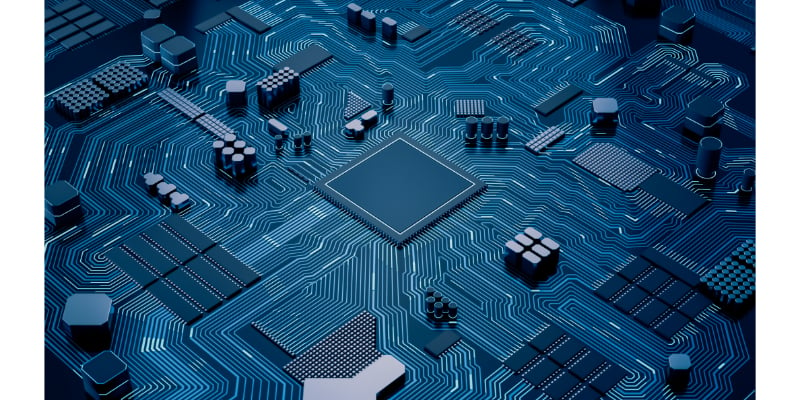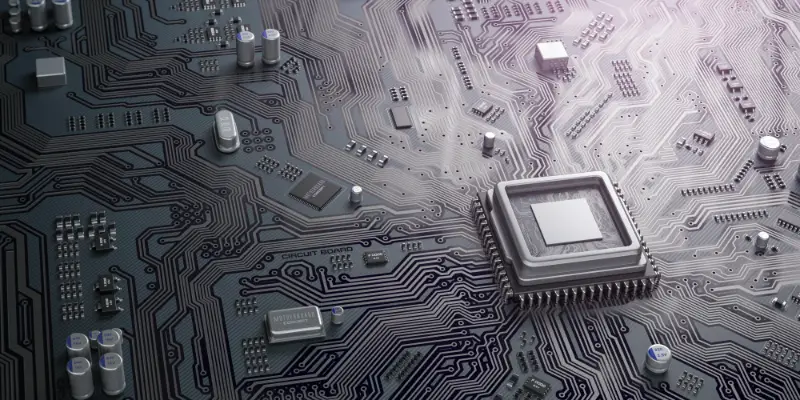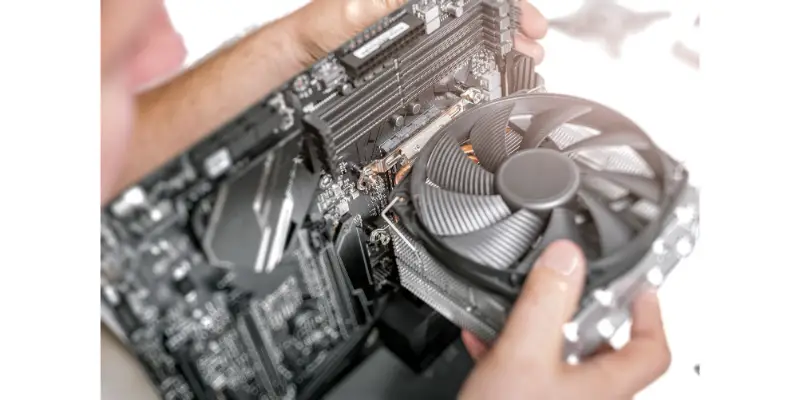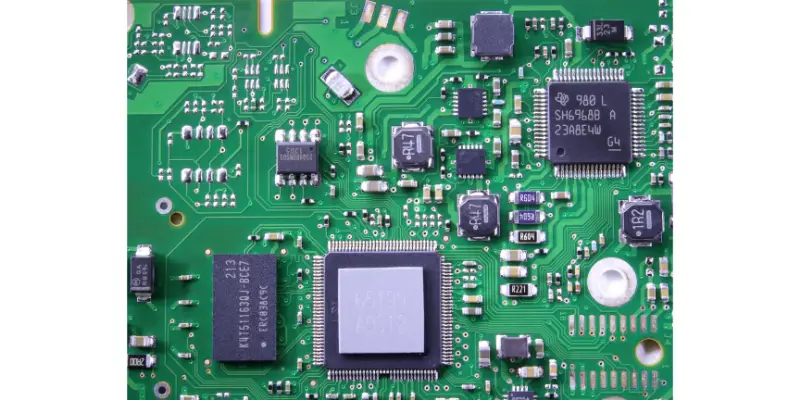Disclaimer: This post may contain affiliate links, meaning we get a small commission if you make a purchase through our links, at no cost to you. For more information, please visit our Disclaimer Page.
If you’ve been reading up on PC hardware, you’ve probably come across the phrase “overheating” more than once. However, it’s not always clear what it means and why it’s so dangerous to your PC.
Overheating the motherboard makes the components expand and lose conductivity. It damages them resulting in thermal runaway, which further damages the PCB. It ruins the motherboard and renders it useless, making it difficult for the computer to perform any task.
Table of Contents
How Do You Know If Your Motherboard Is Overheating?
If you use the PC regularly, you can quickly tell when the heat starts damaging the motherboard. The rule of thumb is that you should avoid exposing your computer to any form of heat because it makes the PC unstable and may damage components. It can make the PC shutdown without any warning.
But you can quickly tell if your computer is heating up. Unexplained shutdowns or when the PC is misbehaving are signs that some components are receiving more heat than normal. Heat damages components and makes them malfunction. Also, when your computer starts rattling, it tells you that the fan is overworking due to overheating. Here are the tell-tale signs that the motherboard is overheating.
Instability issues – when you notice that the system is unstable and it is becoming increasingly difficult for you to perform any task, it is a sign that your computer may be overheating. This will always happen when you subject your PC to rigorous tasks such as playing video games.
Abrupt shutdowns- if your PC shuts down abruptly when you are in the middle of a project, it is a sign that the sink cannot conduct heat away or the fan is unable to bring in cold air to maintain the temperatures. Therefore, to avoid further damage to the components and the motherboard, the computer will shut down.
The blue screen- although many other reasons can make your computer display the blue screen, overheating is one of the main causes of the problem. This can also happen when the machine performs demanding tasks such as encoding videos or even playing intensive games.
Freezes- when your PC freezes without warning, it is a sign that its motherboard is overheating.
Slowdowns- when a computer overheats, it makes it difficult for components to communicate with each other. It leads to malfunctioning including unexplained slowdowns. Also, the computer becomes sluggish, and with time, its performance gets terrible. At some point, it will make you get annoyed and feel like disposing of it.
Spontaneous reboots-when a computer resorts to spontaneous reboots, it is a sign that it is overheating. So, to avoid damaging components, the computer reboots to give itself time to cool off.
Hanging errors- sometimes a computer will hang or display a heatsink, temperature, or a fan error message. When you see such a message, know that the system has malfunctioned because of too much heat.
Shutdowns- overheating is likely to damage some components. For instance, it can damage capacitors or diodes. This may adversely affect the motherboard and make it difficult for the computer to function. It may eventually die off.
When a computer overheats, it gets hot, and any of the above signs ranging from sudden shutdowns, blue screen, and freezes, may be a precursor to a crash. In some cases, when temperatures are too high, the motherboard may catch fire. It leads to the death of the computer.
What Happens When A Motherboard Overheats?
Overheating the motherboard is dangerous. It can damage your computer or reduce its lifetime. If you continue using the computer without taking corrective actions, it is likely to decrease the computer’s lifetime and may damage the components.
Also, when the motherboard overheats, it damages components and decreases the unit’s efficiency. It slows down its speed and reduces the efficiency of the machine. If the overheating is intensive, it may make it difficult to repair the motherboard.
One thing that may happen to you when the computer overheats is to get paranoid. Of course, you will ask yourself why the computer is overheating and wonder loudly what will happen to the CPU when it overheats.
Firstly, it is important to note that the GPU and CPU are made of components that generate heat which makes the computer overheat. So, the computer requires an adequate cooling system to avoid overheating.
Typically, when using the computer, the components dissipate a lot of heat which you need to channel out immediately to allow fresh air to get in and pick the generated heat once more. If this does not happen, the CPU temperature gets past 70 -80 degrees Celsius requiring that you take drastic actions to cool down the PC.
If this does not happen, it will shut down the computer. However, the processor may continue running until some components meltdown.
But when the components start melting, overheating will make the computer freeze, hang or even crash. If you keep on performing the task, you will experience a sudden shutdown.
Sometimes, the computer fan may make some noisy sound, and you may even feel the heat that the PC releases to its immediate environment.
When you restart the computer without taking corrective actions, it will continue to overheat and damage the motherboard and its components. Further, it can burn the CPU and shut down the whole system. In extreme cases, it can lead to a fire outbreak.
Note that each part of the computer system has its own threshold, so some components may overheat when there is an overload while other parts may function normally. If some components overheat and get damaged, the computer shuts up. Meaning that you can repair the damaged parts to revive the computer.
In some other cases, the computer may overheat but remain on. You may hear unusual noise from the fan. It means that the fan may be working hard to regulate the temperature. Suppose this is left to continue for a long time. It deteriorates the components and further reduces the lifespan of the computer.
If the blue screen occurs as a result of overheating, it may shut down the computer. In some cases, the machine may malfunction and may slow down. In other cases, it may display strange graphical artifacts or choose to reboot.
Even if it does not break, if the CPU produces too much heat, it will impact the motherboard and its components.
Some materials expand while others contract when subjected to changes in temperature. So, when the motherboard gets too hot or too cold when the computer shuts down, it exposes the joints to mechanical stress and makes it difficult for the joints to hold the components on the board.
If you subject it to too much stress, it may make the solder fracture and crack. It results in loose or broken connections, which may not allow electricity to flow or make it difficult for the components to communicate with each other.
Regular exposure to high temperatures reduces the level of conductivity of materials. It may further degrade, leading to thermal expansion and runaway that damages the PCB and its components.
Lastly, regular exposure to high temperatures makes the chemical reaction occur and results in corrosion and wear and tear of the capacitors.
Generally, continued exposure to high temperatures damages VRMs and the CPU. It further makes the computer unstable and unreliable. Further exposure to high heat results in instability in the functioning of the computer. This may damage the computer and result in popping capacitors that damage the motherboard and render it unusable.
It could also damage the circuitry tied on CPU, PCI-E lanes, or RAM. It makes it difficult for the hardware to communicate with the system or chipset, causing instability and booting issues.
Can Overheat Damage A Motherboard?
A fully functional fan should remove a certain amount of heat from the computer. Typically, the computer consumes electric energy to perform and execute commands.
It, in turn, dissipates heat which the computer should remove as quickly as possible. But when you deploy the computer to perform more intensive tasks such as playing video games, more heat is generated and may lead to overheating.
If the fan is not working, it may be the beginning of problems. The fan and the sink must be in good condition to remove the heat from the motherboard. If they don’t, it can make the motherboard overheat and get damaged.
Notice that each part of the computer has its temperature threshold. When you expose it to excessive heat, it affects the device’s performance and may damage the motherboard. Overheating shortens the unit’s lifespan and could damage the motherboard beyond repair.
But the motherboard is designed to resist damage even when the temperature gets higher. However, there are cases where the processor damages the motherboard circuitry beneath and causes the BIOS to fail.
Also, overheating may occur when some components are defective. For instance, if the hard drive is misbehaving, the cooling system may likely malfunction. This makes it difficult for the unit to remove the generated heat.
Note that when dust accumulates, it may block the fan or turn it off. Similarly, when the computer vents are blocked or a laptop is not optimized for maximum performance, it can overheat and damage the motherboard.
Further, some apps may misbehave and make the computer generate unnecessary heat. Some of them have anomalous behavior, which makes them consume too many resources and overexert themselves. This may lead to crashes or make components generate more heat which may damage the motherboard.
So, you need to regularly check the PC temperature to help take decisive action before the damage occurs. You can do this by accessing system information, including UEFI, BIOS and through the use of downloaded third-party applications.
The Open Hardware Monitor is one of the software that shows the temperature of the computer hardware and the speed at which the fan is rotating. It also shows the load speed of the computer and other technical aspects that can help you reduce instances of overheating the motherboard.
Use sensors to monitor your computer
Some computers come with sensors that can help you monitor the motherboard and processor temperature. Besides, some sensors can monitor the processor temperature, GPU video cards, and hard drive cards. They will display the temperature to allow you to take corrective action when you notice the temperature getting out of the permitted range.
Typically, ensure that you maintain the following temperature ranges.
· The processor: 4070 degrees Celsius
· Motherboard 40-45 degrees
· Video cards 80 degrees C
· Hard drive 45-50 degrees Celsius
But when you notice that all the components are hot, it may indicate intense overheating and may require that you take corrective actions immediately.
How Do I Cool Down My Motherboard?
A computer motherboard needs regular cooling for it to function optimally. Normally, the motherboard allows the computer to maintain data flow among its components such as RAM, CPU, VGA cards, and HDD/SSD. But when the heat rises beyond a certain level, the processor slows down and could lead to random shutdowns.
In some cases, it may result in reboots and even burning of the components. If you do not take quick action, it can destroy the components and ruin the motherboard, resulting in computer failure. So, you need to regularly check the computer’s motherboard temperature using third-party utility software.
After that, you must maintain the cooling system to maintain stability and lower the temperature on the motherboard. Here are options to help you cool down your motherboard.
Proper Ventilation
Having proper ventilation is critical when trying to maintain the temperature of your computer at certain levels. Proper ventilations maximize airflow and allow air to circulate freely.
So, you must clean and dust air vents regularly and ensure that nothing blocks the PC casing from allowing air to flow. Also, it may be necessary to clean the fan regularly and remove any layer of dirt on its motherboard.
CPUs may also overheat and restrict airflow, so it may be necessary that you clean and dust the CPU to allow air to flow smoothly to the circuits. Always use a brush (soft) when removing the dirt from the components.
Updating The BIOS
Log into the motherboard’s manufacturer and check for BIOS updates. This should always happen when you upgrade windows or change your OS. Each operating system has a separate BIOS driver. The manufacturer will always release an update of the BIOS drivers.
Therefore, when your computer overheats, after an upgrade or installing an OS, solve the issue by updating the BIOS.
Add Fans
Suppose you can add an extra fan to your machine, the better. It helps create a better condition for components and will allow you to deploy the computer to perform different tasks.
If you love playing games on your machine, you need to understand that games require a higher processing power from the GPU and CPU. As a result, it heats the components, including the RAM.
It may result in a very high temperature that damages the motherboard. But by installing a new cooling fan, you will cool down your PC’s components by allowing more air to move in and out of the computer. It cools down the motherboard and allows the computer to function optimally.
The Heatsink Contact
If the heatsink is loosely connected, the motherboard will be affected by excessive heat. So, check and ensure that it is 100% connected to the motherboard. Open the PC casing and assess the motherboard for signs of overheating.
If it is overheating, check how the sink connects to the motherboard. If you see any gap, fill it using a thermal paste.
Consider Replacing The Heatsink With A Fan
If the motherboard has a heat sink, but you notice that it is overheating, consider replacing the heatsink with a fan. This should always be the case when you notice that the host bridge or the Northbridge generates excessive heat.
Only Make Use Of Branded PSU.
If you buy a cheap PSU, you compromise the quality and risk experiencing regular overheating problems. Low-quality PSUs may not provide the power that can adequately support motherboard components. These are low-quality PSUs that will always fail you and result in overheating.
Upgrading Components
If your computer still features the old processors, graphic cards, and VGA cards, they may be inefficient and consume a lot of power for no good reasons. The computer may be incapable of performing tasks at the required speed. You may need to replace them with new components, including installing Solid State Drives on the system. It eliminates the huge Hard Disk Drives that consume a lot of space. The modern SSDs radiate less energy and consume less power.
Disable Overclocking
When motherboards overheat, they overclock. So, the first thing you may need to do is to disable overclocking and ensure that the temperature is not too high. But all motherboards may not support overclocking. Therefore, when you go out to buy a motherboard, ensure to check this feature before spending your money.
Notice that the motherboard remains one of the most vital parts of the computer. It connects to the RAM, the Processor as well as the Graphic Card. Therefore, when the motherboard overheats, it affects the entire PC, including peripheral devices. As such, using a quality motherboard is vital and could allow for maximum output and guarantee reliability.
Place The Tower In A Way That Reduces Overheating
When arranging your desktop towers, ensure to leave some spaces between the towers. You may leave the recommended 5-10 cm of space where the fan is situated. It allows air to flow in and out freely, ensuring that the motherboard does not overheat. Also, ensure to leave some room on either side of the tower that features additional vents.
If the upper part of the cover has vents, don’t cover it with books or containers.
Keep The Fan Clean
The fan will always suck dust, particles, and hair. When they accumulate, they can have fatal consequences to the cooling system. So, ensure that you remove the dust, air, or anything you see sticking on the CPU fan blade or inside the computer.
Such items reduce the speed of cooling and will make your computer run slower. When the dust and dirt are too much, it may heat the motherboard and result in fatal consequences that include computer breakdown.
Conclusion
You will need to be on the lookout and deal with anything that makes your computer overheat. Regular cleaning of the motherboard and computer components is on the top of the list.
Secondly, using self-adhesive rubber feet and coolers could play a role in stopping the laptop from overheating. Check and ensure that there is enough air circulating in the computer. Lastly, always place the computers on even surfaces to encourage free air circulation.




